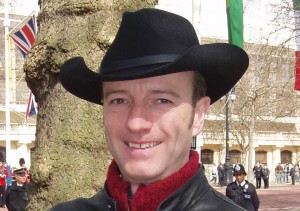I really recommend you check out the project management community on LinkedIn. There are great discussions there and it is a great place to meet other project managers and exchange ideas.
It was in that group that I met Dave Ardent. His great answers caught my attention and we started communicating by email. It soon became a conversation on stakeholder management and I thought I should share it here.

Dave managing a fantastic hat.
Dave Ardentis a project manager, business analyst, consultant, and much more.
He feels a genuine commitment to clients and strives to achieve the greatest results possible for the benefit of not just the organisation but individual people too. The result is remarkable success in satisfying stakeholders in terms of deliverable products, financial benefits, operational performance, and their personal job satisfaction.
Being an independent professional, there is nothing routine about Dave’s work. Each client and project is unique in terms of business context, people, goals, technology, problems, etc. and every day at work is a day focused on making a project successful.
Dave’s varied skills, experience, and successes are recognised by several international organisations, resulting in qualifications and awards that include the PMP, PRINCE2 Registered Practitioner, Certified Scrum Professional, ISEB Certificate in Project Management, and status as Chartered IT Professional.
Many times Dave has demonstrated his ability to walk into even the most chaotic and confused situations and quickly lead people and process to be focused on productive activity in the pursuit of desirable and beneficial results.
Dave delights in a challenge and loves to help people and organisations achieve success.
Here’s our conversation on stakeholder management.
Cesar: Dave, which aspect of project management are you most passionate about?
Dave: I’m passionate about using each project as the focus for delivering positive changes that benefit not just the organisation but its people too. I like to get to know people and find out what they really want, and I strive to make it all a reality no matter how impossible it seems to them. I get enormous satisfaction about creating solutions to unique challenges and surprising people with the results. I’m passionate about ensuring that every project is a remarkable success.
Cesar: That sounds like a lot of stakeholder management. How would you define it?
Dave: Stakeholder Management is the ongoing process of ensuring that all the people that should be involved in the project are involved, in appropriate ways and to an appropriate extent, in order to help ensure the project goes well. It involves gathering and sharing vital information related to the project, and putting it all to good use so that the project can be successful.
Stakeholders can be anyone who has an interest in the success of the project: for example their money is at stake, their professional needs are being addressed, their job is affected, or they share implicit responsibility for it. Stakeholders can include: project sponsor, project executive, business management, partner companies, the project team, customers, end-users, technical advisors, architects, designers, support staff, representatives of user groups, and potentially even the public.
Stakeholders are the source of: funding, strategic goals, project objectives, guidance, decisions, project constraints, requirements, information and advice, feedback, issues, acceptance criteria, and so on. Some need to be involved a lot, some a little.
The significance of Stakeholder Management cannot be over-stated – it is essential to project success. It should be conducted as engaging, positive communication whereby everyone’s necessary contribution is valued. Successful Stakeholder Management helps the Project Manager have access to all the information needed, when needed, so that an effective route to a successful conclusion can be followed.

Managing stakeholders can be tricky.
Cesar: Dave, I absolutely agree with you. As you certainly know, many project managers come from a technical or scientific background, fields that are not necessarily “people oriented.” For many project managers, it is natural to learn and master the tools and techniques of the trade, but it is a challenge to do the same when it comes to stakeholder management, or any other so-called “soft skill.” Last week I interviewed Margaret Meloni on that very topic. Can you give us your perspective on how the project manager can step out of his or her comfort zone and go from, say, managing FTP servers to managing stakeholders?
Dave: First of all, the Project Manager (PM) needs to be organised. Guided by the overall priorities for the project, such as what needs to be delivered first, the PM needs to start to identify who the Stakeholders are. Some of these will be easy to identify, some less so. It may be necessary to ask everyone, “Who else do you think should be involved?” The omission of just one significant Stakeholder could undermine a whole project. Being organised helps reduce stress and provides accessible information on the purposefulness of approaching Stakeholders. A clear sense of purpose and urgency drives us forward.
Next it’s necessary to introduce yourself to Stakeholders. The introduction should be friendly, and immediately state that you are the Project Manager for the X Project, what the purpose of the project is and why it’s important to speak with that person. We want the other person to fully appreciate that there involvement is very worthwhile. The introduction would ideally be in person, else a phone call, else an email. This prioritisation of contact method reflects the best ways to enjoy good relations, effective communication, and cooperation. Once again, being organised promotes low-stress and inevitability about approaching people when you need to.
Finally, when it comes to actually meeting people (or otherwise communicating) we should perceive the person as an individual who has personal preferences as well as professional requirements. First and foremost they are people and we should look forward to meeting them with enthusiasm. If we have a friendly start we easily enjoy a friendly relationship thereafter – and that always makes it easy to approach people and for them to be happy to give us their time. We must communicate that we care about the person’s individual needs in order to be sure of their cooperation, and to be able to ultimately deliver a great result.
We should make it clear to each Stakeholder why the project is important, and why their input is needed. For example, we might clarify why their advice and expertise is necessary to help guide the project to success, or we might communicate that part of the project’s purpose is to deliver improvements for their benefit and so we’re here to start finding out what that person needs.
Always be open and honest with Stakeholders, and allow yourself to enjoy feeling warmth towards them as people, include informal chat in your dealings and allow them to enjoy dealing with you. Think of them as good people who are great to meet. The result can be amazing: people smiling or waving to you when you approach from the far end of the office. Wonderful.
Cesar: Dave, that was a delight. Thanks for sharing your thoughts and I hope to talk to you again and share our conversation with my readers.
